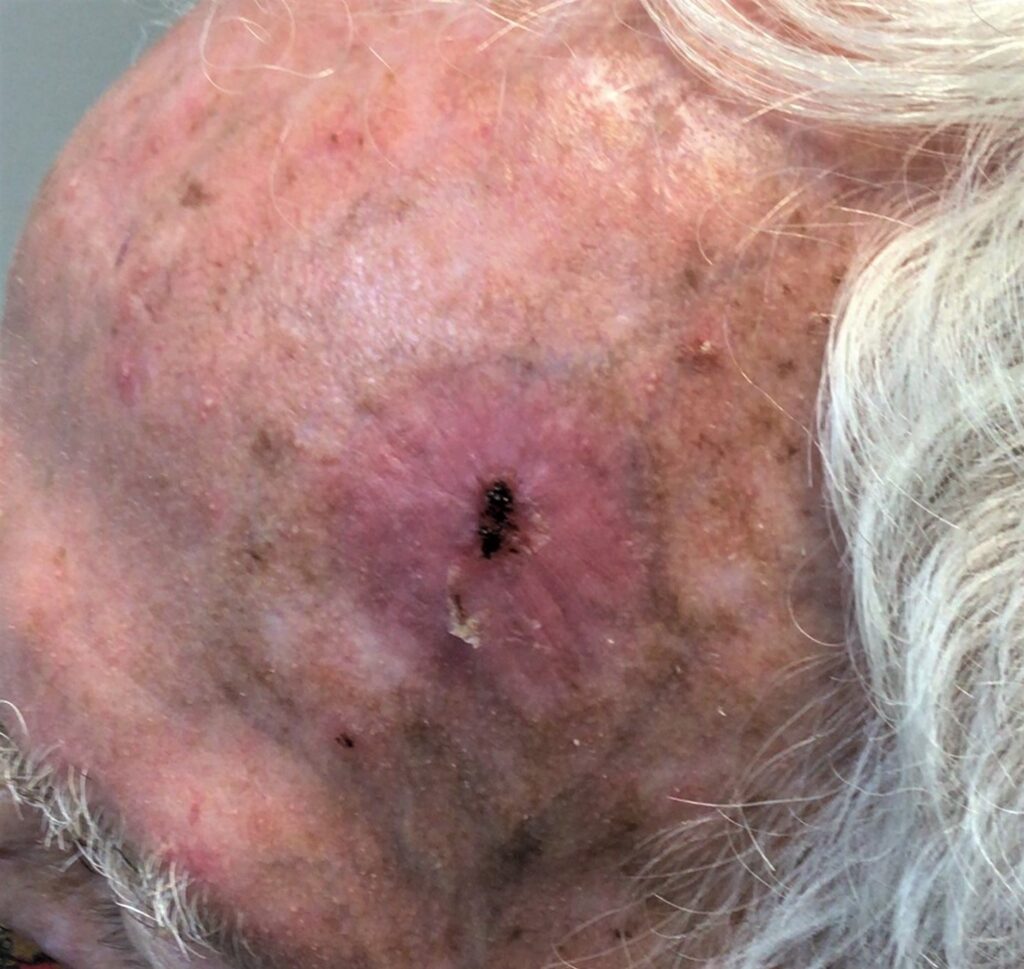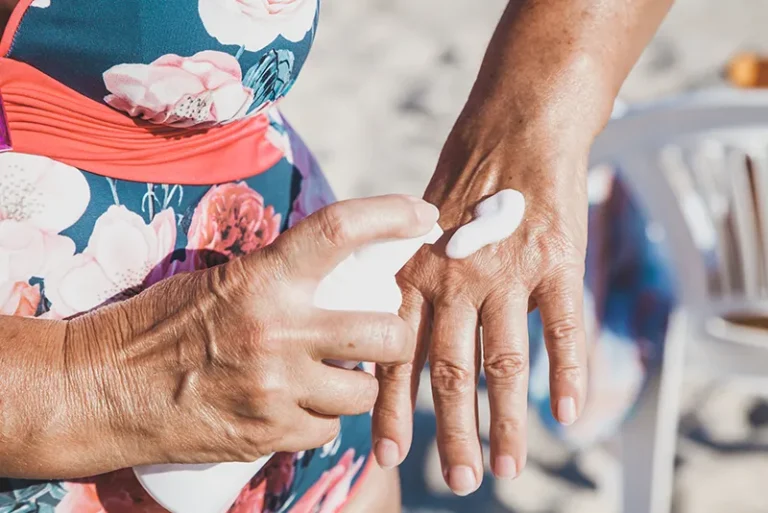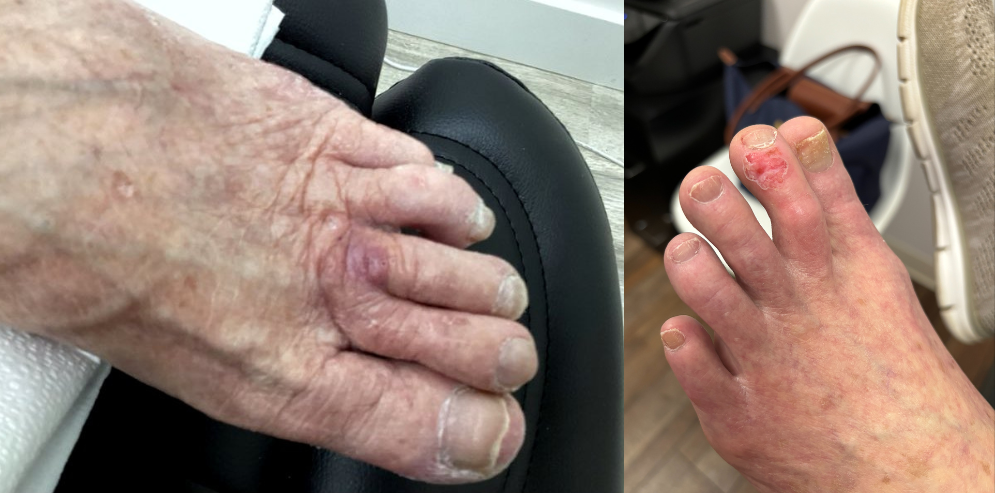
Skin cancer on the forehead usually presents in one of three types: melanoma, basal cell skin cancer, or squamous cell skin cancer. Basal and squamous cell skin cancers are the most common, whereas melanoma is less common but more deadly. When skin cancer develops on the forehead, it’s usually the result of too much exposure to sunlight. Read on to learn more about the symptoms of skin cancer on the forehead, and how to protect yourself when venturing outside.
What Does Skin Cancer on the Forehead Look Like?
Looking at pictures of skin cancer on the forehead, you’ll see abnormal skin growths or spots. This is the most common warning sign. In addition, people with skin cancer on the forehead may or may not notice bleeding from the skin cancer area, and these areas can also become painful. On the forehead or other parts of the body, basal cell and squamous cell skin cancers appear as:
- Flat, firm, pale, and/or yellow areas that look similar to a scar
- Raised reddish patches that might itch
- Small translucent, shiny, and/or pearly bumps that have black, brown, or blue areas
- Pink growths with raised edges that have a lower area in the middle and may include abnormal-looking blood vessels
- Sores that don’t heal
- Rough, crusty, and/or scaly red patches that might bleed
- Wart-like growths
A new or pre-existing mole, freckle, or age spot that changes size, shape, and color can be a sign of melanoma. Other warning signs of melanoma include:
- Dome-shaped growth that feels firm but can bleed
- Slow-growing patch of thick skin that looks like a scar
What are the Risk Factors for Skin Cancer on the Forehead?
Your head and face are exposed to ultraviolet (UV) rays more frequently than any other part of your body. UV rays are a major risk factor for melanoma, basal cell skin cancer, and squamous cell skin cancer. Although exposure to UV rays is the most common cause of skin cancer on areas like the forehead, other risk factors shouldn’t be ignored:
- Light-colored hair and fair or freckled skin
- A lot of moles or irregularly shaped moles
- Sunburn easily and/or have a history of sunburns
- Family and/or personal history of skin cancer
- Precancerous skin conditions, such as actinic keratoses or Bowen’s disease
- A weakened immune system from certain medications or diseases
- Xeroderma pigmentosum — a rare, inherited condition that doesn’t allow skin cells to repair DNA damage caused by sun exposure
- Other inherited conditions, such as Rombo syndrome, Bazex-Dupré-Christol syndrome, epidermolysis bullosa simplex syndrome, and nevoid basal cell carcinoma syndrome (also known as Gorlin syndrome)
How to Prevent Skin Cancer on the Forehead
Staying out of the sun and away from tanning beds, tanning booths, and sunlamps can help reduce your risk of developing skin cancer on your head or face. Checking the UV Index before going outside is a good way to plan how you’ll protect your skin throughout the day. If the UV Index is 3 or above, take precautions to prevent burning:
- Stay in the shade as much as possible.
- Wear a hat with a wide brim that covers your forehead, as well as other sensitive areas like your eyelids, nose, and lips.
- Wear lip balm with an SPF.
- Wear sunglasses that protect your eyes from UV rays.
- Wear a broad-spectrum sunscreen with a sun protection factor (SFP) of 30 or higher. Be sure to reapply after about two hours.
How is Skin Cancer on the Forehead Diagnosed & Treated?
If your dermatologist suspects that you have skin cancer on your forehead or another part of your body, they’ll complete a clinical exam and biopsy. If the sample is positive for skin cancer, they’ll review your treatment options with you. There are multiple skin cancer treatment options, and the right choice for you depends on your individual case. In general, skin cancer on the forehead is treated in the following ways:
- Mohs surgery: If a skin cancer area can’t be fully removed during a skin biopsy, Mohs may be recommended. This treatment method involves cutting the cancerous cells out — layer by layer. Each layer that’s removed is examined for cancer cells. Skin layers are removed until the cancer is no more. Because it’s surgery, Mohs carries certain risks, including bleeding, infection, scarring, pain, tenderness, and the need for reconstructive surgery.
- Radiotherapy: Radiotherapy, such as Image-Guided Superficial Radiation Therapy (Image-Guided SRT), uses X-ray energy to shrink cancer cells until they’re gone. Image-Guided SRT in particular has a 99%+ cure rate but involves no surgery, wound aftercare, or surgical scarring. You can see the skin cancer area disappearing with each session, which typically lasts about 15 minutes over the course of several weeks.
Other methods of treatment, such as cryotherapy, immunotherapy, and chemotherapy, can also be used, especially if a person with skin cancer can’t have surgery for whatever reason.
Learn More About GentleCure™ as a Skin Cancer Treatment Method
If you’ve been diagnosed with basal cell or squamous cell skin cancer on the forehead, GentleCure™ may be right for you. Talk to your doctor about Image-Guided SRT and whether it’s a viable treatment option for your individual case. For more information, contact our skin cancer information specialists online or by phone.








